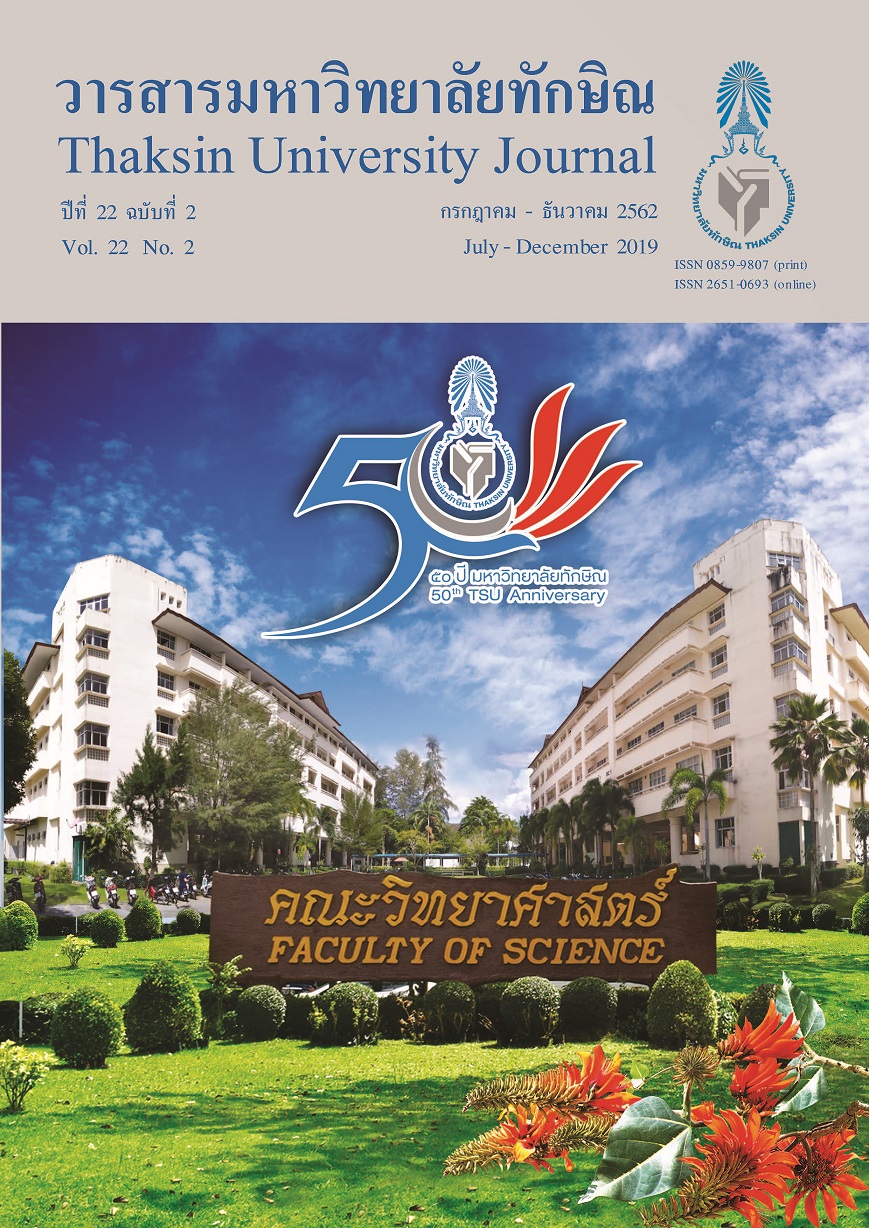Biofuel from Polyhydroxyalkanoates (PHAs)
Main Article Content
Abstract
The limited reserves and negative environmental consequences of fossil fuel have spurred the search for renewable biofuels. Polyhydroxyalkanoates (PHAs) producing-bacteria was proposed as an alternative biofuel, termed as hydroxyalkanoate methyl ester (HAME) and hydroxybutyrate methyl ester (HBME) which are similar to biodiesel. In addition, HAME and HBME are environmental friendly fuel, have high oxygen content without nitrogen and sulfur. In contrast, petroleum contains very low oxygen high nitrogen and sulfur contents, which can lead to environmental pollutions when burning. PHAs are polyesters produced in nature by numerous bacterial, including through bacterial fermentation of renewable carbon sources. The utilization of PHAs as substrate for biofuel seems reasonable at first glance. Consequently, the development of HAME and HBME as sustainable fuel or fuel additives may contribute to the diversification of biofuel or fuel additive market. In this article, production, properties and research of biofuel from PHAs were reviewed. In addition, future work on biofuel from PHAs was also discussed.
Article Details

This work is licensed under a Creative Commons Attribution-NonCommercial-NoDerivatives 4.0 International License.
References
Lee, S. Y. (1996). Bacterial Polyhydroxyalkanoates. Biotechnology and Bioengineering, 49(1), 1-14.
Verlinden, R. A., Hill, D. J., Kenward, M. A., Williams, C. D., & Radecka, I. (2007). Bacterial Synthesis of Biodegradable Polyhydroxyalkanoates. Journal of Applied Microbiology, 102(6), 37-49.
Zhang, X., Luo, R., Wang, Z., Deng, Y., & Chen, G. Q. (2009). Application of (R)-3-Hydroxyalkanoate Methyl Esters Derived from Microbial Polyhydroxyalkanoates as Novel Biofuels. Biomacromolecules, 10(4), 707-11.
Russell, R. A., Holden, P. J., Garvey, C. J., Wilde, K. L., Hammerton, K. M., & Foster, L. J. (2006). Investigation of the Phase Morphology of Bacterial PHA Inclusion Bodies by Contrast Variation SANS. Physica B: Condensed Matter, 385-386, 859-861.
Valentin, H. E., Lee, E. Y., Choi, C. Y. & Steinbüchel, A. (1994). Identification of 4 Hydroxyhexanoic Acid as a New Constituent of Biosynthetic Polyhydroxyalkanoic Acids from Bacteria. Applied Microbiology and Biotechnology, 40(5), 710-716.
Sudesh, K., Abe, H., & Doi, Y. (2000). Synthesis, Structure and Properties of Polyhydroxyalkanoates: Biological Polyesters. Progress in Polymer Science, 25(10), 1503-1555.
Filemon, A., & Uriarte, J. (2010). Biofuels from Plant Oils. ASEAN Foundation, Jakarta, Indonesia. ISBN No. 978-979-19684-1-6.
Wanga, S.Y., Wanga, Z., Liu, M.M., Xub, Y., Zhang, X.Y., & Chen, G.Q. (2010). Properties of a new gasoline oxygenateblend component:3-Hydroxybutyrate Methyl Ester produced from Bacterial Poly-3-Hydroxybutyrate. Biomass and Bioenergy, 4(8), 1216-1222.
Keunun, P., Rakkarn, T., Yunu, T., Paichid, N., Prasertsan, P., & Sangkharak, K. (2017). The Production of Polyhydroxybutyrate by Two-step Fermentation and the Application of Polyhydroxybutyrate as A Novel Substrate for a Biolubricant. Journal of Polymers and the Environment, 26(6), 2459-2466.
Choonut, A., Yunu, T., Pichid, N., & Sangkharak, K. (2017). The Optimization Conditions of Polyhydroxybutyrate Methyl Ester from Polyhydroxybutyrate via Acid-catalyst. Energy Procedia, 138, 435-440.
Sangkharak, K., Nisa, P., Yunu, T., Srinak, K., Sornnum S., & Prasertsan, P. (2016). Biofuel Production, Characterization and Degradation 3-Hydroxybutyate Methyl Ester from Polyhydroxybutyrate. Chiang Mai Journal of Science, 43, 808-817.
Guo, Y. (2005). Alkaline-catalyzed Production of Biodiesel Fuel from Virgin Canola Oil and Recycled Waste Oils. Doctoral Dissertation. Hong Kong: University of Hong Kong.
Junpadit, P., Boonsawang, P., & Suksaroj, T. T. (2014). Polyhydroxyalkanoate Production from Palm Oil Factory Wastes and Its Application for 3-Hydroxyalkanoate Methyl Esters as Biofuels. In The International Conference on Sustainable Energy and Environment (SEE 2014): Science, Technology and Innovation for ASEAN Green Growth. 67-70. November 19-21, 2014, Anantara Bangkok Riverside Resort & Spa, Bangkok: King Mongkut’s University of Technology Thonburi (KMUTT).
Canakci, M., & Gerpen, J.V. (1999). Biodiesel Production via Acid Catalysis. American Society of Agricultural Engineers, 42(5), 1203-1210.
Lotero, E., Liu, Y., Lopez, D. E., Suwannakarn, K., Bruce, D. A., & Goodwin, J. G. (2005). Synthesis of Biodiesel via Acid Catalysis. Industrial & Engineering Chemistry Research, 44(14), 5353-5363.
Ma, F., & Hanna, M. A. (1999). Biodiesel Production: A Review. Bioresource Technology, 70(1), 1-15.
Musa, I. A. (2016). The Effects of Alcohol to Oil Molar Ratios and the Type of Alcohol on Biodiesel Production using Transesterification Process. Egyptian Journal of Petroleum, 25(1), 21-31.
Freedman. B., Butterfield, R. O., & Pryde. E. H. (1986). Transesterification Kinetics of Soybean Oil. Journal of the American Oil Chemists’ Society, 63(10), 1375-1380.
Leung, D. Y. C., & Guo, Y. (2006). Transesterification of Neat and Used Frying Oil: Optimization for Biodiesel Production. Fuel Processing Technology, 87(10), 883-890.
Leung, D. Y. C., Wu, X., & Leung, M. K. H. (2010). A Review on Biodiesel Production using Catalyzed Transesterification. Applied Energy, 87(4), 1083-1095.
Kueanun, P., Yunu, T., & Sangkharak, K. (2016). The Utilization of Sugarcane Molasses as a Substrate for Polyhydroxybutyrate and Its Application. In The 12th Conference on Energy Network of Thailand (E-NETT 12th), June 8-10, 2016, Wangchan Riverview Hotel. Phitsanulok: Naresuan University.
Silverstein, R., Bassler, G. C., & Morrill, T. C. (1991). Spectrometric Determination of Organic Compounds (5th Ed). New York: John Wiley & Sons, Inc.
Steinbüchel, A., & Valentin, H. E. (1995). Diversity of Bacterial Polyhydroxyalkanoic Acids. FEMS Microbiology Letters, 128(13), 219-228.


